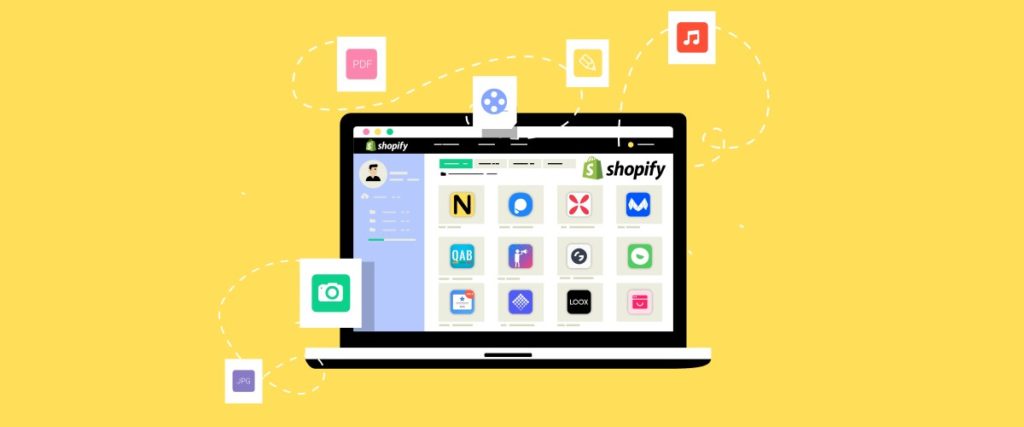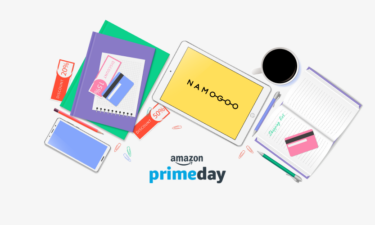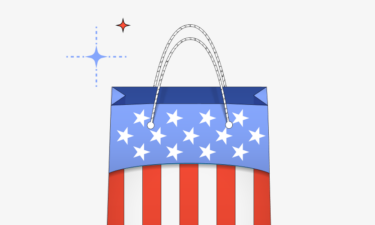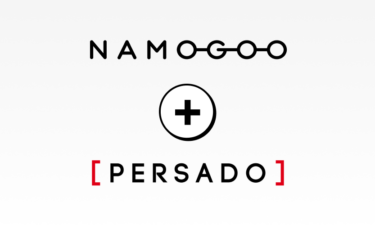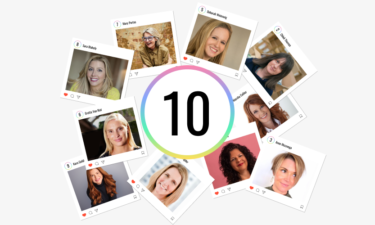Pop-ups: whether you’re experiencing them as an online shopper, or doing a risk/reward analysis as a UX team, pop-ups are controversial.
But they’re also effective. By using time or behavior to trigger a pop-up, you can snag the user’s attention before they leave your site.
Because 97% of eCommerce site traffic leaves without converting, pop-ups often save the day.
After all, they provide a method of collecting data and re-engaging users. And if you don’t have a way to engage those users before or after they bounce, they’re most likely gone forever.
You just have to implement pop-ups on your site strategically. If you want to use them the right way, you need a powerful, customizable Shopify pop-up app.
Below, we’ll compare popular pop-up apps, including pricing and pros and cons.
What Are Shopify Pop-up Apps (And Why Should You Use Them)
How to Use Pop-ups to Improve the Onsite Customer Experience
The Top Shopify Pop-up Apps for eCommerce Teams
Drive Sales, Build Your Email List And Engage Users With These Top Pop-Up Apps for Shopify Stores
What Are Shopify Pop-up Apps (And Why Should You Use Them)
Shopify pop-up apps are tools that deliver trigger-based pop-ups built specifically for the eCommerce platform Shopify.
Because Shopify is such a powerful platform, these apps are usually easy to install and your first pop-ups can be launched in less than a day.
Which is good news for eCommerce sites looking to optimize their conversion funnels.
If you landed on this article because you searched for the best Shopify pop-up apps, chances are you don’t need to see a business case for implementing pop-ups on your brand’s eCommerce store.
But if you’re on the fence, the numbers don’t lie. Pop-ups can convert between 10-30% better than other lead generation modalities[*], and if you use them strategically you can leverage this controversial interstitial to improve rather than impair the customer experience on your website.
How to Use Pop-ups to Improve the Onsite Customer Experience
To make the most out of pop-ups, ensure that they load quickly and don’t affect page loading times, are easy to close, and contain a simple, easy-to-follow call to action.
You can use them to meet a wide range of marketing or conversion goals including:
- Building your email list
- Promoting a new product
- Collecting feedback
- Finding out why your visitors are leaving
- Providing customer service
- Offering a lead magnet
- Promoting a product recommendation quiz
- Reminding visitors about a sale or promotion
- Promoting your social media channels.
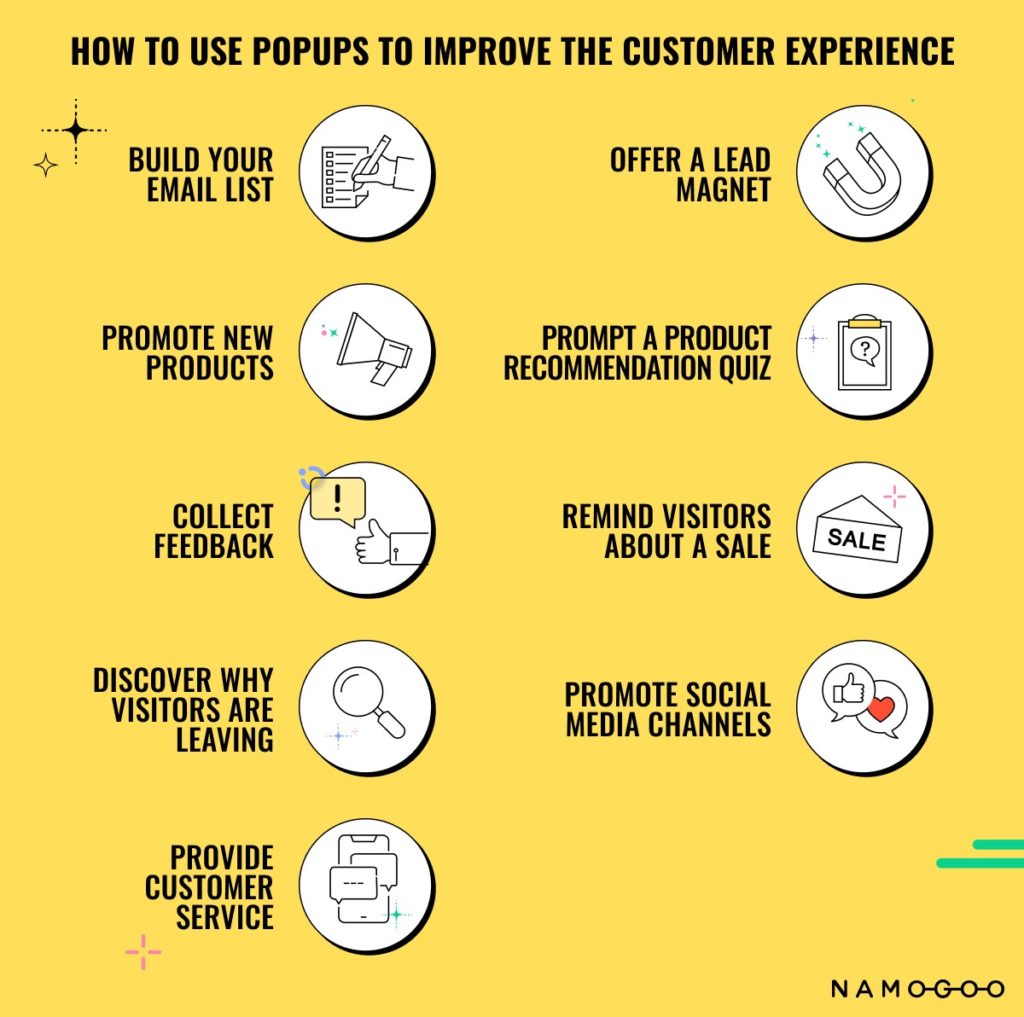
The versatility of pop-ups is one of their greatest benefits. No matter what goal you are trying to reach, strategically-placed and created pop-ups can help you get there.
The Top Shopify Pop-up Apps for eCommerce Teams
For a quick, visual overview of the top Shopify pop-up apps, reference the comparison table below.
Legend:
- Green checkmark: Yes, feature included!
- White slash: Feature partially included.
- Red ex: Feature not included.
The Top Shopify pop-up Apps for eCommerce Teams
Aside from convincing your team to try pop-ups, the next challenge is finding the right tool for your store. There are dozens of options, but we curated nine of the most popular Shopify pop-up apps and why they might be a good choice for your store.
#1 Shopify Pop-up App: Intent-Based Promotions from Namogoo
Price: Starts from $166/month
Free trial: Yes
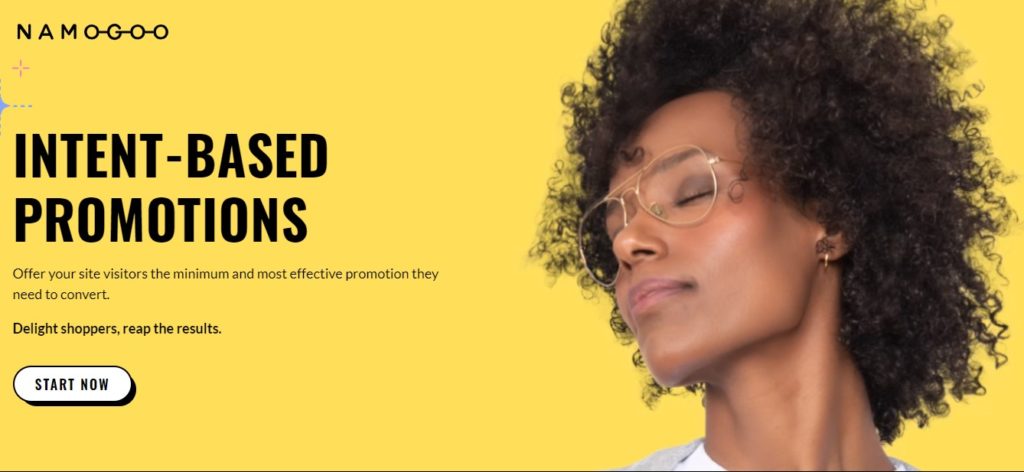

Intent-Based Promotions uses machine learning and artificial intelligence to deliver hyper-relevant pop-up offers to increase not only your conversion rate, but also average order value, customer lifetime value, revenue per visitor, and more.
It does so by processing billions of data points collected from the top eCommerce sites in the world to calculate each customer’s purchase intention and analyzing user behavior and signals to determine the minimum effective promotion each shopper needs to convert.
Not just a run-of-the-mill pop-up app, Intent-Based Promotions enables eCommerce teams to leverage the power of personalization and behavioral-based marketing to improve performance at every stage of the buyer’s journey.
The best part about this Shopify pop-up app is that it drives both long- and short-term growth. That’s because the powerful, AI “brain” will not serve a promotion to those visitors who either have no intent to buy or who don’t need one to complete their order.
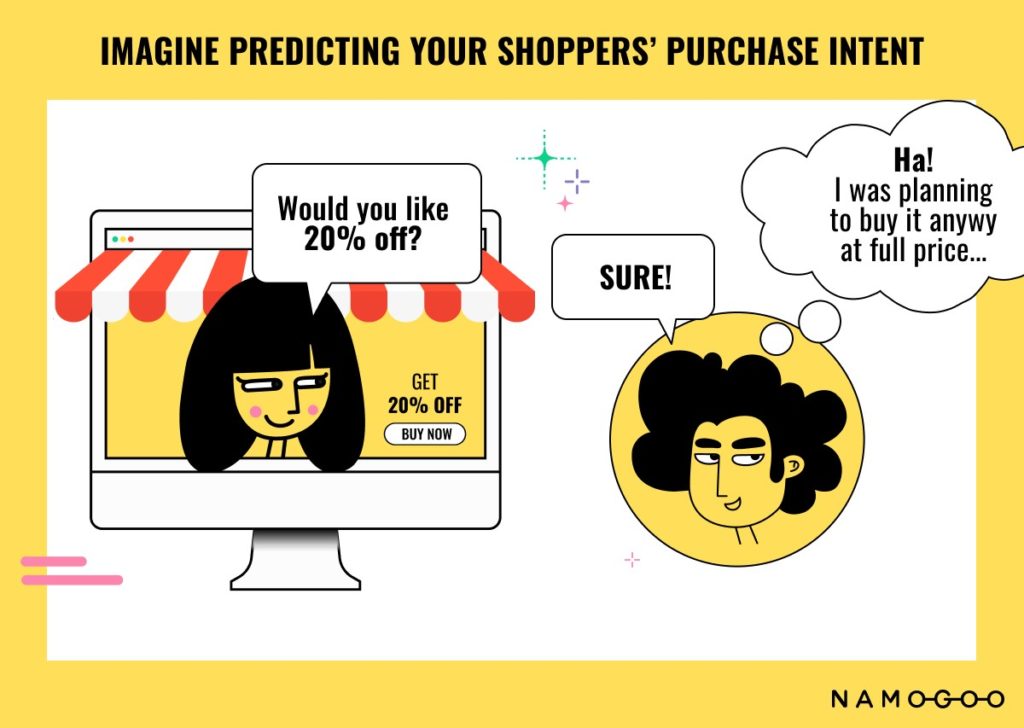
With Intent-Based Promotions, you can avoid training users to expect a discount and protect that brand equity you worked so hard to build.
Bonus: the coupon codes delivered via Intent-Based Promotions are single-use, personalized codes that are only relevant to the individual customer who is served the pop-up. That means that the codes won’t end up on a third-party coupon affiliate site.
Intent-Based Promotions is mobile-friendly, doesn’t affect site loading times, has comprehensive and flexible targeting options, beautifully designed customizable templates, and a code-free implementation. But the real reason it’s the top Shopify pop-up app is that it does so much more:
Pros:
- Hyper-relevant offers
- Uses user behavior to design more effective offers
- Uses non-PII data to offer the most profitable incentive at the lowest cost possible.
- Drive growth in all the eCommerce KPIs that matter
- GDPR-ready and cookieless data collection to serve personalized incentives in a post-iOS 14 world.
- Built specifically for eCommerce stores with a feature set that meets the unique needs of online retailers.
Cons:
- Limited form options
- Meant for online stores with a minimum of 150 orders per month, so is not the best choice for new Shopify sites.
#2. Popupsmart
Price: Starts at $24 a month
Free trial: Yes, for up to 5,000 pageviews
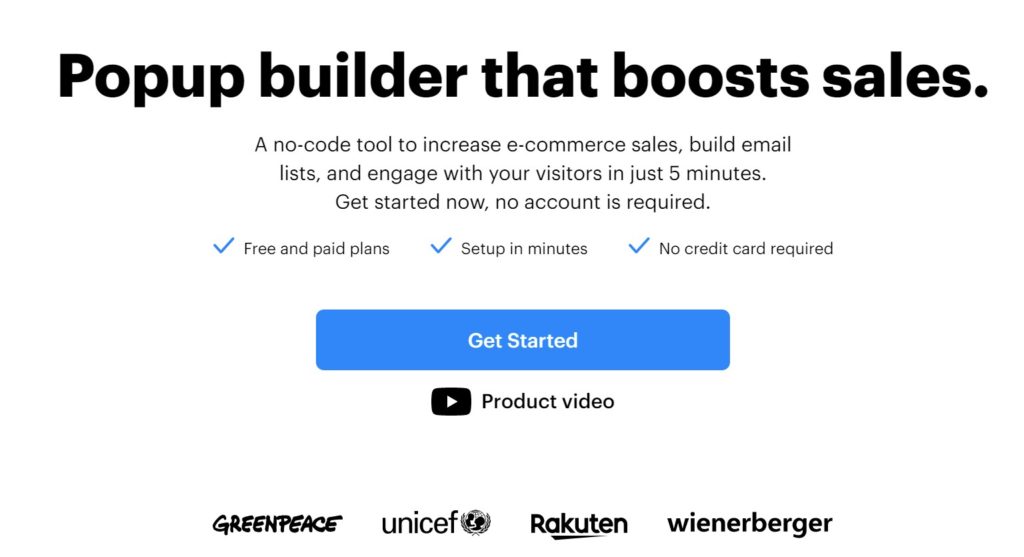
Popupsmart is a code-free tool designed with user experience in mind. It’s easy to install, so you can get your pop-ups launched in minutes. Features of note include easy to use (but customizable) templates, a variety of targeting options (including exit-intent, location, and scroll time), and the ability to prefill forms.
Popupsmart campaign goals are easy to set with their “recipe” feature, which makes it simple to design a campaign from start to finish. Want to collect emails, drive sales, or engage with customers? They’ll help you get it right.
They also offer “pop-up teasers,” mini pop-ups that don’t disturb users and expand to a full pop-up when users click.
Pros:
- Customizable templates
- Targeting options
- Code-free implementation.
Cons:
- Limited documentation on customization options
- Hard to migrate from current platforms
- Limited integrations (though they do connect with Zapier)
#3. Wisepops’ Pop Ups and Bars
Price: From $49 per month
Free trial: Yes, 14-days

Wisepops’ Shopify app is an easy-to-use pop-up app your whole team will love. It’s easy to install and features a drag-and-drop editor for creating elegant pop-ups in seconds. The intuitive interface means you can achieve your marketing goals with fewer clicks.
They also provide detailed targeting options, so you reach the perfect customers at just the right time. Targeting options include time, user behavior, location, cart value, and much more.
It was built with Shopify users in mind, which means you can use Shopify-specific targeting options. Wisepop also makes it easier to send data to the rest of your marketing stack so you can see exactly what works and what doesn’t.
Pros:
- Simple, easy to use
- Easy to customize
- 30+ targeting options based on time, behavior, or actions
- Dynamic content
Cons:
- The pricing structure is by page view not pop-up display.
- Limited report automation features
- Goal tracking is a bit complicated
#4. Quick Announcement Bar by Hextom
Price: Paid plans start at $9.99 a month
Free trial: Yes; free plan with limited features
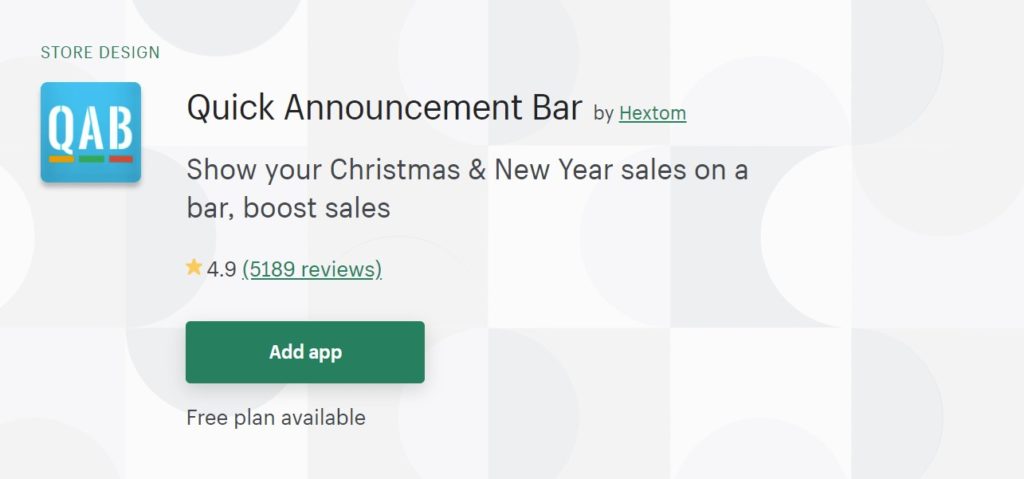
Quick Announcement Bar is a Shopify pop-up app that helps drive sales by converting visitors into customers. Features include advanced targeting based on country, time, traffic source, and collections, a wide range of templates (including holiday themes), and button animation.
You can use the tool to drive different types of conversions and build user engagement. For example, brands can collect email addresses, promote a new product line, or notify visitors of an upcoming sale.
Pop-ups can be auto-scheduled, which means you can schedule banners weeks in advance. They also offer advanced performance tracking so you can see which banners or pop-ups are most effective.
Pros:
- Advanced targeting options
- Templates for easy pop-up design
- Mobile responsive
- Optimized for all screen sizes
- Affordable
- Free version
Cons:
- Reviewers report glitches that prevent the bars from displaying
- Fewer template and targeting options than other tools
- Lacks the ability to personalize the pop-ups to the user
- Can reduce site load time.
#5. Sales Pop by MakeProSimp
Price: $4.99 per month
Free trial: Yes, limited free plan
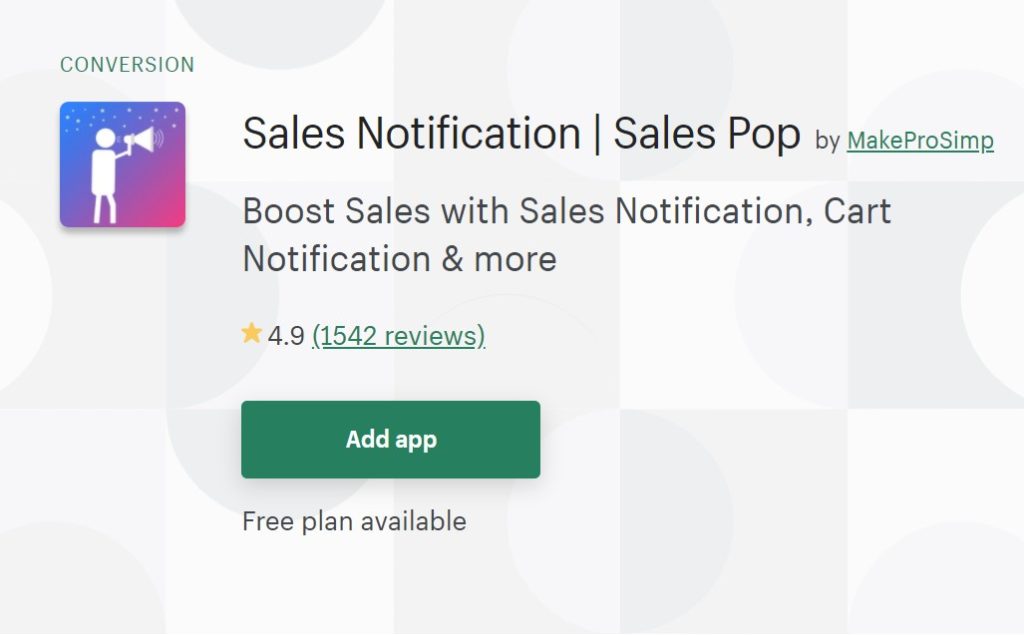
Sales Pop’s Sales notification tool is a sales-focused Shopify pop-up app. While other tools focus on building email lists, Sales Pop focuses on driving sales with pop-ups for cart display, sharing social proof, and online visitor notifications.
Features of note include customizable messages, location, display time, and more. The tool also makes it easy to hide notifications for specific pages or specific products so you can target users most likely to convert. They also offer advanced tracking and analytics so your organization can focus on efforts that drive real sales.
Pros:
- Affordable
- Easy setup
- Focuses on sales and conversions, not just collecting emails
- Exclusion rules ensure you pop-ups only show when you want them to
- Use UTMs to track conversions in GA
Cons:
- Fewer templates and targeting options than other tools
- Lacks the ability to personalize the pop-ups to the user
- Limited customer support.
#6. Upsell, Discount, Email pop-ups by Getsitecontrol
Price: Starts at $9 per month
Free trial: Yes, 14-day free trial
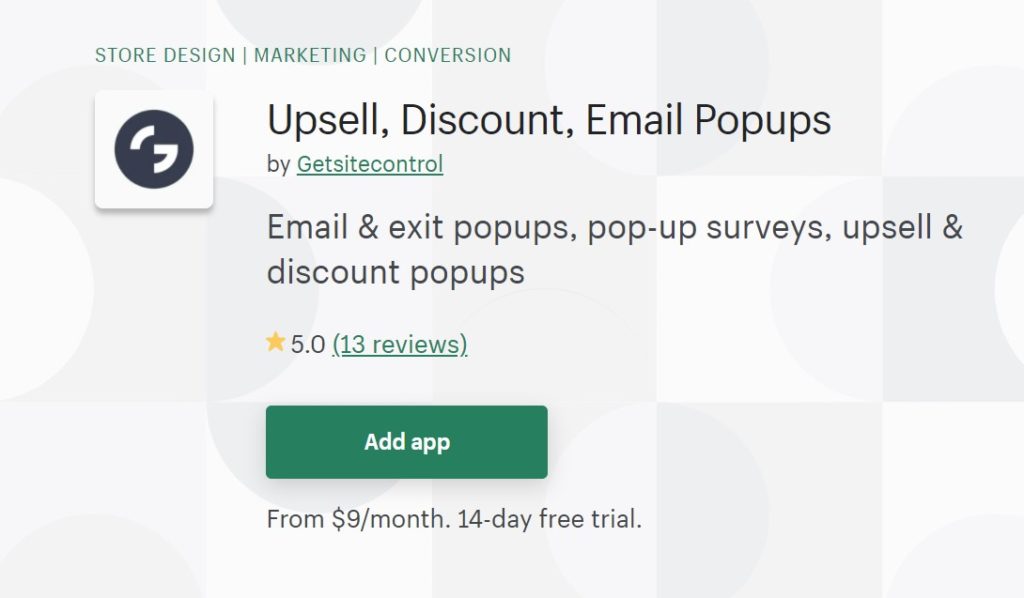
While most eCommerce businesses use pop-ups for email collection, it has a host of other benefits. This Shopify pop-up app from Getsitecontrol helps businesses do more with pop-ups, including upselling gift cards, discounts, upping order value, and more.
If you’re looking to do more with pop-ups, this might be the tool for you. Features include smart display triggers, cross-selling pop-ups, cart abandonment tools, shipping cost bars, surveys and polls, and age verification pop-ups. All pop-ups can be customized in a CSS editor and feature easy installation.
Pros:
- Promote a wide range of campaigns, not just email collection
- Plenty of display triggers to choose from
- Easy pop-up installation
- Integrates with email providers and tools like Mailchimp, Google sheets, and Zapier
Cons:
- Limited templates, compared to other tools
- No white-labeling
- Limited targeting options
- No drag-and-drop feature
- Lacks the ability to personalize the pop-ups to the user.
#7. Mailmunch
Price: Paid plans start at $14.99 per month
Free trial: No; they do have a limited free plan, however
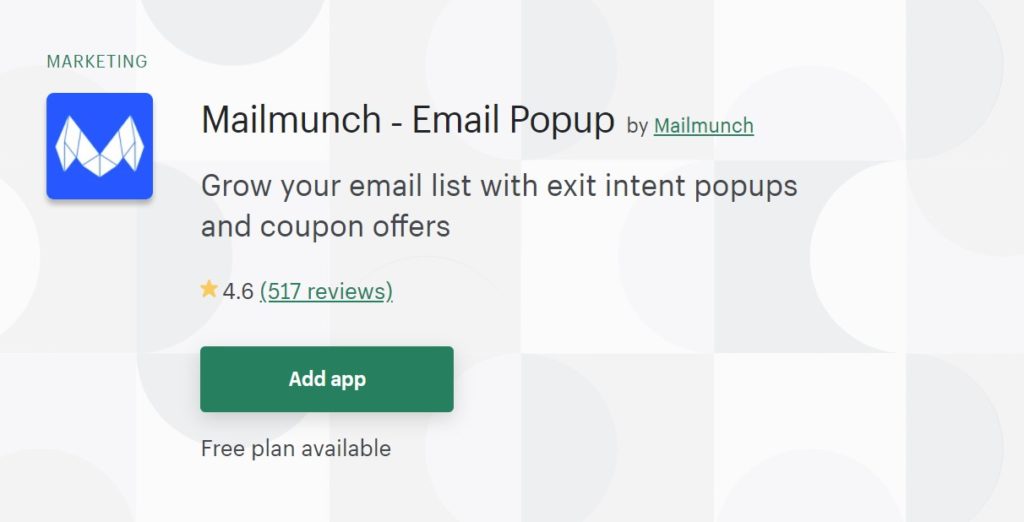
Pop-ups don’t exist in a vacuum. Most businesses use them as part of a larger conversion campaign — which is where Mailmunch’s email pop-up tool really shines. In addition to the standard pop-up features, like templates and forms, they also offer landing page building.
Features of note include unlimited subscribers (no more surprise bills!), form and pop-up builders, dozens of templates, detailed analytics, and custom domains. They offer three tiered plans, with the highest tier offering access to more templates and content gating. Mailmunch also makes it easy to create autoresponder emails right in the platform.
Pros:
- Affordable, especially for the features
- Landing pages and form builders
- Detailed analytics to track campaign success
- Premium templates (on highest tier plan)
- Unlimited subscribers on all plans
- Access to content gating (highest plan)
Cons:
- Their site doesn’t list much about targeting options, so those may be limited
- Have to get the higher plan to get access to better features, like more templates and content gating
#8. Justuno
Price: Paid plans start at $29 per month
Free trial: Yes, free plan and free 14-day trial

Justuno Is one of the more popular Shopify pop-up apps — and one of the only tools that is a Shopify partner. That means it works particularly well with the Shopify platform. But is it the right tool for you? It depends on your goals.
Popular features include pop-ups, banner offers, exit intent offers, and upsell promotions and product recommendations. They also allow you to capture both email and SMS numbers in the same pop-up, so you can expand your communication methods. You can also A/B test, use timers to show pop-ups at the right time, and leverage optimized templates.
Pros:
- Email and SMS data collection
- Time-based campaigns for easy holiday promotions
- Intelligent up-selling features to show dynamic recommendations
- Shopify partner
- Plenty of integrations
Cons:
- Paid plans are tiered by visitor sessions, which can add up
- More detailed functions aren’t as beginner-friendly
- Design tool can be difficult to navigate
#9. Popup by POWR.io
Price: Paid plans start at $3.99 per month
Free trial: No, they do offer a limited free plan, however

Need an affordable, easy-to-use Shopify pop-up app? Popup from POWR.io might be the right tool for your business. Features include easy-to-use templates, a customizable welcome mat, the ability to collect phone numbers, survey features, and the ability to send autoresponder welcome emails.
Popup also includes time-saving integrations like Zapier, Mailchimp, and Google Sheets so you can send new contacts wherever you need them.
Pros:
- Powers coupon codes
- Collects phone numbers
- Offers support in multiple languages
Cons:
- Lower tiers have limited features; for example, you can’t control display frequency on the Starter plan
- Limited customization options
- Limited customer support
Drive Sales, Build Your Email List And Engage Users With These Top Pop-Up Apps for Shopify Stores
Pop-up apps are a simple but effective way to increase engagement and build your email list.
No matter which tool you select from this list, make sure to follow Google’s best practices to avoid impacting your store’s organic search rankings.
Remember, pop-ups are only effective when they are useful for the visitor, so use them carefully.



